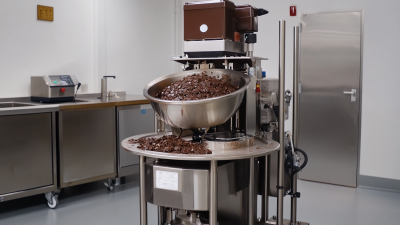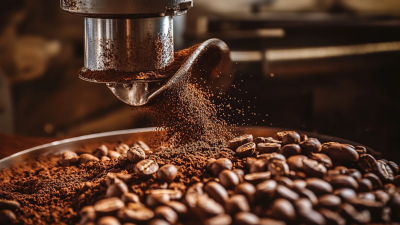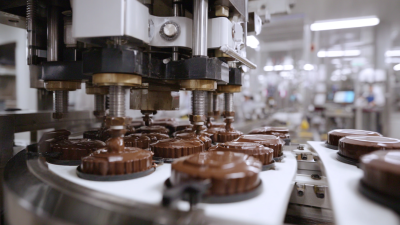What is the Process of Choosing the Right Chocolate Making Equipment for Your Business
 The chocolate industry is experiencing a remarkable growth trajectory, with reports indicating that the global chocolate market is projected to reach USD 162.5 billion by 2024, driven by rising consumer demand for premium and artisanal products. As chocolate businesses expand to meet this demand, choosing the right chocolate making equipment becomes crucial for success. The selection process involves various considerations, including production capacity, equipment versatility, and technological advancements to ensure quality and efficiency. According to a 2022 market study, about 30% of chocolate manufacturers cite equipment failure as a significant barrier to production scale-up. Thus, understanding the intricacies of selecting optimal chocolate making equipment is imperative not only for product quality but also for operational sustainability and profitability in a competitive market.
The chocolate industry is experiencing a remarkable growth trajectory, with reports indicating that the global chocolate market is projected to reach USD 162.5 billion by 2024, driven by rising consumer demand for premium and artisanal products. As chocolate businesses expand to meet this demand, choosing the right chocolate making equipment becomes crucial for success. The selection process involves various considerations, including production capacity, equipment versatility, and technological advancements to ensure quality and efficiency. According to a 2022 market study, about 30% of chocolate manufacturers cite equipment failure as a significant barrier to production scale-up. Thus, understanding the intricacies of selecting optimal chocolate making equipment is imperative not only for product quality but also for operational sustainability and profitability in a competitive market.
Understanding Your Chocolate Production Needs and Goals
Choosing the right chocolate making equipment is crucial for any business aiming to produce high-quality chocolate products. To start, it is essential to understand your specific production needs and goals. For instance, according to a market report by Grand View Research, the global chocolate market is expected to reach $160 billion by 2025, which highlights a growing demand for artisan and premium chocolates. This surge requires businesses to align their equipment choices with their production capacities and product differentiation strategies.
 When assessing your chocolate production needs, consider factors such as volume, product variety, and target market. If your goal is to produce small-batch, artisanal chocolates, investing in tempering machines and conching equipment designed for precision may be advantageous. A study published in the International Journal of Food Science & Technology identified that the quality of equipment used directly impacts the sensory attributes of chocolate, influencing consumer preferences. Businesses must evaluate the size and efficiency of machinery to ensure they can meet not only current demands but also future growth, keeping in mind that customer trends toward organic and sustainable chocolates are on the rise.
When assessing your chocolate production needs, consider factors such as volume, product variety, and target market. If your goal is to produce small-batch, artisanal chocolates, investing in tempering machines and conching equipment designed for precision may be advantageous. A study published in the International Journal of Food Science & Technology identified that the quality of equipment used directly impacts the sensory attributes of chocolate, influencing consumer preferences. Businesses must evaluate the size and efficiency of machinery to ensure they can meet not only current demands but also future growth, keeping in mind that customer trends toward organic and sustainable chocolates are on the rise.
Evaluating Different Types of Chocolate Making Equipment Available
When it comes to choosing the right chocolate-making equipment for your business, evaluating the different types available is essential. The market offers a variety of machines designed for specific purposes, from bean-to-bar production to tempering and molding. Each type of equipment plays a critical role in ensuring the quality and consistency of your chocolate products. For instance, refining machines help achieve the desired texture by grinding cocoa nibs, while conching machines enhance the flavor by aerating the chocolate mixture.

Additionally, consider the scale of your operations when selecting equipment. Small-scale artisanal chocolatiers may benefit from manual or semi-automated machines, which allow for greater control over the chocolate-making process. In contrast, larger manufacturers may require fully automated systems capable of handling higher volumes efficiently. It's also important to factor in space requirements and ease of cleaning, as these elements will affect both your production workflow and overall hygiene standards. Investing time in evaluating your options will ultimately lead to better equipment choices that align with your business goals.
Key Features to Look for in Quality Chocolate Machinery
When selecting chocolate-making equipment for your business, several key features play a crucial role in ensuring the machinery meets your production needs. First and foremost, consider the capacity of the machines. Depending on your production scale, you might require equipment that can handle small batches for artisanal creations or larger machines that can accommodate high-volume outputs. Look for machines that offer flexibility in settings, allowing you to experiment with various recipes and chocolate types.
Another important aspect to evaluate is the quality of construction and materials used in the machinery. High-quality equipment not only enhances the taste and texture of the chocolate but also ensures durability and efficiency. Features such as easy-to-clean components and reliable temperature control are essential for maintaining product consistency and hygiene. Additionally, consider machinery that incorporates technology for precise monitoring, as this will aid in achieving the desired quality and streamline your operations, ultimately contributing to your business’s success in the competitive chocolate market.
What is the Process of Choosing the Right Chocolate Making Equipment for Your Business - Key Features to Look for in Quality Chocolate Machinery
| Feature | Description | Importance |
|---|---|---|
| Material Quality | High-quality stainless steel is essential for maintaining hygiene and durability. | Critical |
| Production Capacity | Must match the demand of your business to avoid overloading or underutilization. | High |
| Ease of Use | User-friendly controls and clear instructions for minimal training. | Moderate |
| Energy Efficiency | Equipment that reduces energy consumption can save costs long term. | High |
| Technical Support | Access to reliable customer service for maintenance and troubleshooting. | Critical |
| Customizability | Ability to adapt machinery for different types of chocolate products. | Moderate |
Budgeting for Your Chocolate Equipment Investment
When investing in chocolate making equipment, budgeting is a crucial first step. The global chocolate market is projected to reach $161.56 billion by 2024, and having the right equipment is essential for seizing market opportunities. Depending on the scale of your operation, initial investment can vary significantly; small artisanal setups may require $10,000 to $50,000, while larger manufacturing units could see costs soar to over $200,000. Keeping track of these expenses can help you plan effectively and avoid unexpected financial strains.
**Tip:** Before making any purchases, conduct thorough research on the equipment’s efficiency and longevity. For instance, consider machinery that has a lower operational cost, which may lead to savings in the long run. Additionally, seeking financial assistance through grants or loans specifically tailored for food production can help mitigate initial investment risks.
It's essential to factor in additional costs beyond the equipment itself, such as maintenance, training for staff, and potential upgrades. A recent report indicated that 58% of chocolate businesses experience unexpected repair costs that were not initially budgeted for. Being prepared for these hidden expenses can save your business from jeopardy and ensure a smoother operational flow.
**Tip:** Create a detailed budget that includes all potential costs, and revisit it regularly to adjust for fluctuating market conditions and equipment performance. This proactive approach will lead to more informed financial decisions and sustainable growth for your chocolate-making venture.
Budget Allocation for Chocolate Making Equipment
Maintenance and Support Considerations for Long-term Success
Choosing the right chocolate making equipment is crucial for any business aiming for long-term success, especially when maintenance and support considerations come into play. Regular maintenance schedules can significantly extend the lifespan of equipment, which is vital in an industry where machinery failure can lead to costly downtime. According to industry reports, businesses that implement a comprehensive maintenance program can reduce equipment breakdowns by up to 40%, translating to more consistent production and higher product quality.
Moreover, selecting equipment from suppliers that offer robust support services is essential. A survey from the Chocolate Manufacturers Association indicated that 75% of businesses experienced at least one significant issue with equipment during their first year of operation. Those who partnered with manufacturers providing ongoing training and dedicated support were able to resolve these issues more efficiently, minimizing operational disruptions. Companies should prioritize suppliers not only for the quality of their equipment but also for their commitment to customer service and maintenance support, ensuring a smooth operational flow and a competitive edge in the chocolate market.
Related Posts
-

5 Essential Features of the Best Chocolate Manufacturing Equipment
-

Essential Tips for Sourcing High-Quality Commercial Chocolate Production Equipment
-

Experience Unmatched Chocolate Quality with Our Advanced Conching Machine
-

Essential Checklist for Selecting the Best Cocoa Grinding Machine in 2023
-

China's Intelligent Chocolate Machines Redefining Global Quality Standards
-

What Makes the Best Chocolate Manufacturing Machine Essential for Your Business
